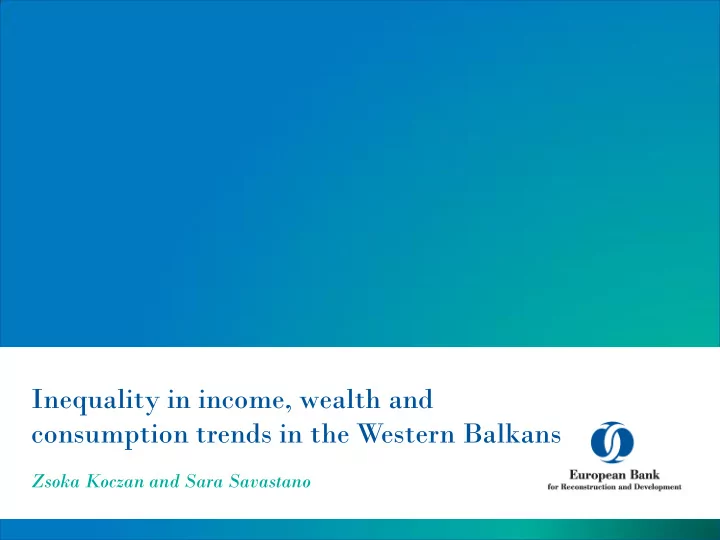

Inequality in income, wealth and consumption trends in the Western Balkans Zsoka Koczan and Sara Savastano
Severe recessions of 1990s, boom years of early 2000s Recessions, (hyper)inflation in 1990s, sustained economic growth until the GFC Per capita GDP growth, percent Source: IMF World Economic Outlook and authors’ calculations. 2
Structural reforms lagged behind NMS Sequence similar, but progress more limited, in particular on governance and large-scale privatizations Transition indicators in the Western Balkans and New Member States Source: EBRD and authors’ calculations. 3
Income convergence also stalled after the GFC Convergence slower than in NMS, and stalled in the aftermath of the crisis GDP per capita, percent of EU-15 average Market exchange rates PPP Source : IMF World Economic Outlook and authors’ calculations. 4
Unemployment rates remain higher than in NMS Only limited employment gains even in boom years, large job losses during GFC Unemployment rates, percent Source : IMF World Economic Outlook and authors’ calculations. 5
Remittances remain an important source of income Remittances, percent of GDP Source: IMF World Economic Outlook, World Bank and authors’ calculations. 6
Poverty fell during the boom years Early 2000s brought steady increases in incomes; some increase in poverty since the GFC Headcount, percent below 1.9 PPP USD/day Source: Povcal and authors’ calculations. 7
Some improvement in other measures of poverty At risk of poverty or social exclusion : equivalised disposable income below 60 percent of national median Severely materially deprived : at least 4 out of the following 9 (cannot afford to pay rent or utility bills, keep home adequately warm, face unexpected expenses, eat meat/fish/protein equivalent every second day, a week holiday away from home, car, washing machine, TV, telephone) Source: Eurostat and authors’ calculations. 8
Inequality increased in boom years, fell after Inequality increased in most countries in early 2000s, but peaks vary across countries Today inequality broadly comparable to that in NMS Gini coefficients in the Western Balkans and New Member States Source: Povcal and authors’ calculations. Right panel refers to 2015 or most recent year before that; lighter colours 9 denote consumption rather than income based estimates.
Consumption share of top increased then fell Similar patterns in quintile (top 20/ bottom 20) and Palma (top 10/ bottom 40) ratios Consumption shares in the Western Balkans and New Member States Source: Povcal and authors’ calculations. 10
Average growth rates do not apply to significant sections of the populations Up to ¾ of the population experienced below-average growth Incomes of large shares of the population not converging, or even below 1989 levels Income growth by percentiles of the population, 1989-2016 Source: EBRD Transition Report 2016-17. 11
Growth has not benefited all Curves shifted up as growth benefited at least some deciles, but also became steeper, pointing to stark increases in inequality Cumulative income growth since 1989 by income decile Source: EBRD Transition Report 2016-17. 12
Challenges ahead Legacy of incomplete transition, loss of ‘employer of last resort’ but private sector development lagging Reforms stalled in mid-2000s and remain incomplete, weighing on growth and employment Sense that reforms have under-delivered, inequality has increased Complete structural transformation process, Find new engines of growth and sources of employment Build political support for reforms Greater awareness and recognition of historical context increased job insecurity, privatizations, concentrated labour market shocks, lagging development of private sector, pensions and remittances as shock absorbers… 13
Recommend
More recommend